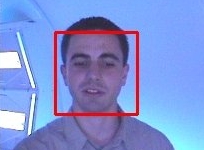Rackham

Visual Human Detection
The genom module ICU (for "I see You") is launched during interaction at long (>3 meters) and medium ([1,3] meters) range H/R distance. LAAS has investigated on vision-based modalities dedicated to detection/tracking of persons, and eigenfaces-based recognition modality in order to (re)-identify persons during any proximal H/R interaction session. The functions provided by the module ICU are organized into three broad categories: (1) functions related to human body limbs detection, (2) functions related to user face recognition, (3) functions related to user tracking.
1- Human body limbs detection
In order to interact with the user of Jido / Rackham, ICU need to detect and extract some cues related to the human body limbs. Three main detectors are used.
(1) Face detector
 For detecting faces, we apply the well known window scanning technique introduced by Viola et al. which covers a range of ±45 ° out-of plane rotation. This detector is based on a boosted cascade of Haar-like features.
For detecting faces, we apply the well known window scanning technique introduced by Viola et al. which covers a range of ±45 ° out-of plane rotation. This detector is based on a boosted cascade of Haar-like features.
(2) Skin colored blobs detector
 Detecting skin-coloured pixels provides a reliable method for detecting human faces or hands. Classically, the ratio of the two histograms modeling respectively the skin and background distributions makes it possible to apply Bayes rule to each image pixel in order to obtain its skin-coloured probability.
Detecting skin-coloured pixels provides a reliable method for detecting human faces or hands. Classically, the ratio of the two histograms modeling respectively the skin and background distributions makes it possible to apply Bayes rule to each image pixel in order to obtain its skin-coloured probability.
(3) Motion blobs detector
 The motion blob detector is based on the difference between successive pairs of frames. It can coarsely outline a mobile ROI that can be integrated in our tracking loop.
The motion blob detector is based on the difference between successive pairs of frames. It can coarsely outline a mobile ROI that can be integrated in our tracking loop.
2- User face recognition
The face classification is splitted in two parts : the representation of the faces and the decision-making process.
The representation of the faces is based on the eigenfaces in order to reduce the size of the data. Each person is represented by an eigenface base. Then, the
decision is done by a simple Bayesian rules based on our error norm inspired from the Distance From Face Space (DFFS).


3- User tracking
As described previously, ICU must be able to follow the targeted person at different H/R distances. To deal with these ranges (from 1 to 3 meters, more than 3 meters), ICU embed two different tracker based on particle filtering : the upper human body tracker and the motion monitoring. The first one follows the person interacting with the robot at medium range and use the face recognition to know if the user in known. The second is launched when the user is to far for direct interaction (more than 3 meters) and is mostly based on motion detection. These modalities are managed by a finite state automaton that automatically switch between the appropriate modality (Motion monitoring, Upper human body tracking, Face detection).